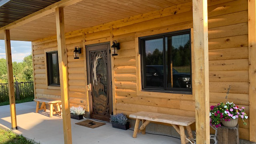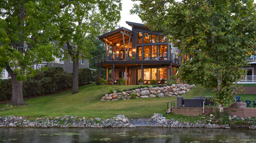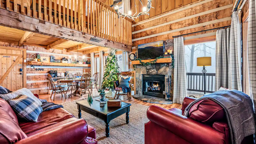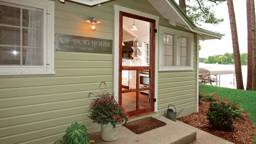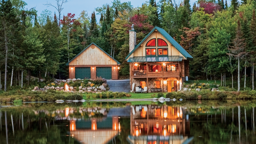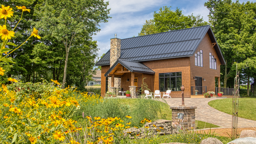INGENUITY – When the Johnsons installed a modern entry door, they made use of the cabin’s original one for a shallow pantry. “It’s a practical use for an antique. It gives us storage and also finishes off the side of the refrigerator,” says Greg. (see next photo)
In the 1860s, newspapers buzzed with news of free land available to those willing to farm it. “Go West, young man” was the refrain, and people were doing just that, to the vexation of the already under-populated state of Maine.
Soon after, then-Maine-Governor Joshua Chamberlain proclaimed, “If we cannot keep our sons at home, let us bring in our cousins,” and dispatched a delegation to Sweden in search of industrious folks to farm the upper wilds of the state. Twenty-two men, 11 women and 18 children answered the call and formed “New Sweden,” a colony in Maine’s far northeast corner.
It was there in 1888 that Carl Johnson arrived from ‘the old country’ and is presumed to have built the cabin with the traditional steep roof and neatly dovetailed corners, which now overlooks Cundy’s Harbor and Dingley Island.
“Carl Johnson was my great-grandfather,” explains Greg Johnson, a trim, spectacled man in his 60s, looking relaxed in a pin-striped shirt and boat shoes on the cabin’s screened-in porch. “And my grandfather and father were born here, too. Right over there,” he says gesturing toward a log wall of what is now the living area. “That was the birthing room.”
Nearly 100 years after the cabin’s construction, it fell into disrepair from sitting vacant for decades. So it was disassembled, the logs were carefully marked and their wooden peg fasteners put in potato barrels. Then the whole thing was stored in a barn. And there it sat.

Rebuilding a Family Legacy
Ten years later, the Johnsons graded a field by the farm’s inlet near the harbor for a plot on which to reconstruct the ancestral home.The cabin was reconstructed in two phases. First, craftsman Larry Totten tackled the initial design work, which included reconfiguring and expanding the original cabin to include a full basement, two additional bedrooms and a gourmet kitchen. And then he carefully and passionately reassembled the logs. “Without his craftsmanship and passion, we couldn’t have gotten this project going,” says Greg.
AN ADVENTURE IN SALVAGING LOGS
THE FINISHING WORK
Once the cabin was framed up and assembled, it was time for the second phase of construction. In came builder Robert Moulton, of Bath, Maine, and his crew to do the finishing work.“Both builders [Moulton and Totten] were creative and a pleasure to work with,” recalls Greg. “It was really an awful lot of ad-hoc design as we moved along. Joy was the creative spirit who made the construction project into a wonderfully warm home.”

Life in Style
The treasured cabin, now named “Farfar Stuga,” which translates from Swedish as Grandfather’s Cottage (or literally, Father’s-Father’s Cottage), is by no means a museum. Greg and Joy lived in the cabin for an entire year while their farmhouse was remodeled. “We were quite comfortable,” he says. Unlike their ancestors, the couple enjoyed modern conveniences like in-floor radiant heat and a wood-burning Scan stove from Denmark.The cottage’s primary function, however, is to house overnight visitors. “It’s a guesthouse and also a place to entertain,” says Greg. Part of the experience is the cabin’s history. “Over the past six years, it seems that all of the guests we have entertained always want a ‘tour’ of the cabin and a summary of its history.”
And the extended family also recently held Greg’s mother’s birthday at the cabin, a celebration that gathered many around favorite foods, including traditional rye bread made from his mother’s recipe. “It makes great toast,” confesses Greg.
But the prime use of Farfar Stuga seems to be the couple’s enjoyment of their adult children and grandchildren, whose names are stenciled high along the living room’s walls between ceiling beams.

Swedish Décor & Style
Although the cabin has grown, one original aspect that remains honored is the detailed Swedish styling. “Much of it is based on the style of Swedish artist Carl Larsson,” says Greg, who credits Joy for the cabin’s authentic décor.This includes the interior’s simple whitewash over the ceilings and exposed beams that brings lightness to the space. Another nod to old-time Swedish architecture was building charming bed cubbies into walls and even adding traditional secret compartment built-ins to the cabin. “These details aren’t just authentic, they’re fun, too,” smiles Greg as he pulls a perfectly obscured pine box from within the stairwell.
The simplicity of traditional Nordic décor, with its clean lines, also gives the cabin a modern flair. Joy has cleverly married seemingly opposing details of plain sticks inserted into slots on the heavy beams as holders for sleek, metal lights above the living room. This marrying of old with new relaxes the space, making it easy to enjoy – which the Johnsons clearly do.

Cabin Stats
• Farfar Stuga is approximately 19x26 feet.
• Of the cabin's 1,800 square feet, 750 is the original homestead cabin and 1,050 encompass the additional bed and bathrooms.
• New screened-in front porch is 8x26 feet.






